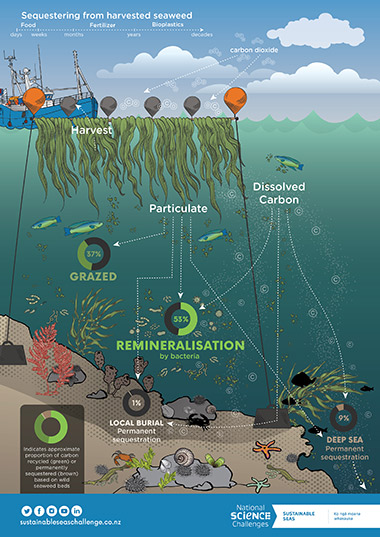FAQ
Why should I join ANSZA?
2. Networking with other people and organisations in the seaweed industry
3. Opportunity to help to shape a new emerging industry in Aotearoa New Zealand
What steps do I need to take to grow seaweed in Aotearoa New Zealand?
See MPI’s – setting up a marine farm
Check with your local council as there may be specific requirements in your region.
Review the reports and infographics (scroll to the end of the page) produced by Sustainable Seas Challenge project Building a seaweed sector, which cover various aspects of this question
What are global seaweed market trends?
- >35 million tonnes of worldwide production
- Aquaculture production predominantly meets the global demand
- Annual global growth rate ~ 7 %
- Less developed countries currently have greater market share
- The majority of both production and consumption is driven by Asian countries, although demand is increasing across the globe, including in the United States. Top producing Asian countries include China and Indonesia.
- Diversity of species and end-products is increasing; most products are food related
- There is a global movement toward more plant based diets and products, particularly in Western countries.
What is Ecosystem based management?
Please refer to the Sustainable Seas reports: https://www.sustainableseaschallenge.co.nz/tools-and-resources/virtual-lab-ebm-in-nz/
Where can I learn more about the global seaweed sector?
Please refer to this Sustainable Seas Challenge report, Seaweed sector: Market and regulatory focus (August 2021) and accompanying infographic about the global seaweed sector
Where can I learn more about Aotearoa New Zealand’s seaweed sector?

Where can I learn more about the pathways of carbon flow from seaweed aquaculture?
Please refer to the Sustainable Seas Challenge report, Environmental effects of seaweed wild-harvest and aquaculture (November 2021) and accompanying infographic which visualises the carbon cycle within a seaweed farm

What are the positive and negative impacts of farming seaweed?
Please refer to the Sustainable Seas report Environmental effects of seaweed wild-harvest and aquaculture (November 2021), and accompanying infographic
What is Aotearoa New Zealand’s strategy around aquaculture?
Please refer to the government’s published Aquaculture strategy:
Where do I learn more about Te Tiriti o Waitangi considerations with respect to seaweed?
Refer to the Sustainable Seas Challenge report Stocktake and Characterisation of Aotearoa New Zealand’s seaweed Sector (November 2021)
Where can I get more information about the seaweed sector in Aotearoa New Zealand?
Refer to the following:
Building a seaweed sector project, Sustainable Seas National Science Challenge
What are some of the barriers and gaps impeding the Aotearoa New Zealand seaweed sector?

Does seaweed sequester carbon?

Carbon cycle within a seaweed farm · This infographic shows the pathways of carbon flow from seaweed aquaculture based on measurements and calculations of carbon sequestration pathways in wild seaweed beds (Krause-Jensen & Duarte 2016). The amount of carbon removed from the ocean in harvested seaweed is not quantified.